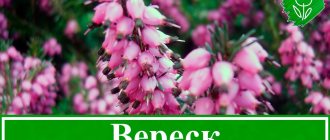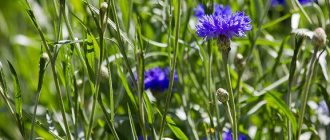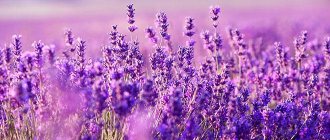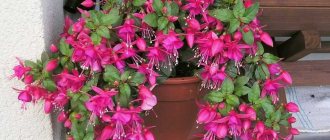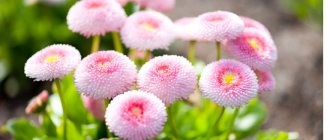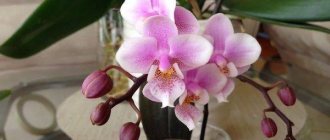Author: Elena N. https://floristics.info/ru/index.php?option=com_contact&view=contact&id=19 Category: Garden plants Published: February 13, 2019Last edits: October 18, 2021
- Where and when to plant
- Growing conditions
A drink from the heather Forgotten a long time ago. And he was sweeter than honey, Drunker than wine...
grass (lat. Calluna vulgaris) is an evergreen plant, the only species of the Heather genus of the Ericaceae family, which today numbers about 500 varieties, many of which have high decorative qualities. Heather grows in Europe, extending from the tundra to the coniferous-deciduous forest zone, in Greenland, North Africa, the Azores, temperate Asia and the Atlantic coast of North America, preferring forests, peat bogs and burnt areas. An old Scottish legend tells that heather was the only plant that agreed, at the request of the Creator, to grow on the bare rocky hills blown by the wind, as a reward for which it was endowed with endurance, unpretentiousness, a pleasant aroma and a modest but alluring charm. And to this day, where heather grows, nothing else grows - large areas covered with heather are usually called heather heaths. By the way, it was heather that gave the name to September in the Ukrainian, Belarusian and Polish languages - veresen, verasen, wrzesien.
Botanical description
Common heather (Calluna vulgaris) is an evergreen, highly branched shrub 20-100 cm high. It has a creeping and erect form. Erect stems with leaves arranged in a stepped tiled pattern form a beautiful wide crown.
Heather leaves have no petiole and look like needles. They have a triangular shape. Their size is only 2.5 mm in length and up to 2 mm in width. Heather leaves are arranged in 4 rows.
Heather becomes most decorative after frost, when its leaves turn bright burgundy and yellow.
Heather is a long-liver. The lifespan of the plant reaches 45 years with annual flowering.
When can you plant common seasonal heather in open ground in different regions?
Russia extends over 3 climatic zones, so the temperature regime in the regions is different. This affects the duration of the summer season as a whole, and directly on the planting of perennial plants.
In outskirts of Moscow
Heather is sold in nurseries and stores all year round, but this does not mean that planting is also possible at any time. The most favorable time for planting: late April or September. This way the plant will not be damaged by frost and will be able to take root. An important rule: do not buy seedlings in advance. At home, the plant wakes up and begins to actively grow leaves. Heather does not like transplanting.
In Siberia
Planting heather in Siberia is recommended in the spring. It is best to carry out field work in May. Then the plant will have time to take root and grow without the risk of damage to the root system. Landing is allowed in early September. The air temperature this month remains stable, which has a beneficial effect on foreign varieties that do not like temperature changes. But there is a risk that the plant will not have time to take root before the onset of frost.
In the Urals
Although wild heather shrubs are common in the flora of the Urals, planting an ornamental plant in open soil requires a special approach. If we are talking about foreign heat-loving varieties, then it is better to refuse planting in the garden.
It is recommended to plant seedlings in spring. Due to the harsh climate, planting shrubs in the fall is not recommended. As a last resort, you can do this in August.
Pharmacological properties
Heather provides:
- anti-inflammatory;
- antispasmodic;
- painkiller;
- enveloping;
- astringent;
- diuretic;
- expectorant;
- antimicrobial;
- disinfectant;
- soothing;
- wound healing;
- diaphoretic action.
The drug with heather is taken orally in the form of teas, tinctures, decoctions and infusions. Used externally to treat skin and inflammatory diseases, wounds and abrasions.
Heather tea
Active ingredients
Heather leaves represent a very promising source of triterpenoids.
Numerous triterpenoids, including ursolic and oleanolic acids, have antitumor and anti-inflammatory properties. A new property of ursolic acid has been described in heather acetone extract that may help explain the plant's anti-inflammatory properties.
The quercetin content may explain the plant's nerve-soothing effect. The aqueous extract has the highest phenol content.
Indications for use
Due to its complex effects on the body, heather is used in the treatment of a wide range of diseases.
Most effective for colds and inflammatory diseases. It is prescribed for the treatment of complex pneumonia, tuberculosis, and rheumatism. The plant is part of medicinal stomach, kidney, sedative, cold, and antiallergic preparations.
The plant is prescribed for:
- Skin diseases and inflammations of the mucous membranes:
- allergic rashes;
- furunculosis;
- eczema;
- psoriasis;
- trophic and other ulcers;
- stomatitis;
- angina;
- periodontal disease, etc.
- Gastrointestinal diseases:
- gastritis with high acidity;
- stomach and duodenal ulcers;
- heartburn;
- dysbacteriosis;
- pancreatitis;
- cholecystitis;
- hepatitis of various forms;
- to increase appetite.
- Diseases of the kidneys and urinary tract:
- stones in the ureters and kidneys;
- cystitis;
- inflammation of the prostate;
- urethritis;
- pyelonephritis.
- To restore metabolism in diabetes, obesity, atherosclerosis.
- For pneumonia, bronchitis, cough of various etiologies.
- ENT diseases:
- tracheitis;
- laryngitis;
- pharyngitis;
- sinusitis;
- rhinitis and others.
- In complex therapy of oncology.
- For neurological problems and in cases of depression, nervous tension, insomnia.
Heather has a general strengthening effect, improves immunity. When taking medications containing plant extract, nails and hair are noticeably strengthened and skin condition improves.
Improves hair condition
Chemical composition
The inflorescences of common heather have a fairly diverse chemical composition. The main compounds that make up this plant are carbohydrates, followed by protein, carbon lipids.
It is possible to identify sucrose, fructose and glucose, five organic acids, 26 individual fatty acids and four tocopherol isoforms. As for the composition of the extract, it contains 12 phenolic compounds with a predominance of myricetin-3-O-glucoside and myricetin-O-rhamnoside.
Regarding biologically active effects, the more polar extracts have not only the highest amount of phenolic compounds, but also the strongest antioxidant and antibacterial activity. In contrast, for anti-inflammatory and cytotoxic potential, the most effective extracts were n-hexane and ethyl acetate, respectively.
The antimicrobial activity of phenolic compounds from heather is also significant.
The plant also contains vercetin, arbutrase enzyme, citric and fumaric acids, starch, resins, gum, flavonoids, carotene, potassium compounds, phosphorus, sodium, organic acids, coumarins, steroids
Contraindications for use
No side effects were found for drugs containing heather. However, there are contraindications.
- In case of individual intolerance to the plant.
- Not recommended for use by pregnant and lactating women. This is due to the high content of essential oils.
- Due to its tonic effect, heather is contraindicated in severe psychoneurological disorders.
- For patients with gastritis with low acidity, preparations with heather are strictly prohibited. They tend to reduce acidity and coat the mucous membrane, which is unacceptable in the hypoacid form of the disease.
conclusions
- Heather is a perennial plant that requires little care.
- It is better to plant heathers in spring.
- Be sure to oxidize the soil before planting.
- Heather does not like excessive humidity. If there is a risk of flooding, install drainage.
- Most varieties of heather need to be watered only during prolonged hot weather and drought.
- In central Russia, the shrub survives in winter without insulation, but it is still better to prepare it for wintering.
- Heather can be propagated by layering, seeds, seedlings, or dividing the bush.
- The plant is rarely susceptible to disease.
- Due to its beneficial properties, the plant is used in agriculture, medicine and landscape design.
Features of heather
Heathers are unpretentious plants and can be found everywhere. With the exception of steppes and deserts. In tropical climates they grow in highlands.
Due to the microscopic size of the seeds, heather is carried by the wind over enormous distances, 100 kilometers or more. Scientists have proven an interesting fact: seeds from Sweden were carried by the wind to the Jutland Peninsula.
Heather plants form unusual communities - heathers. They are dense thickets in the center of which there is a bare space - heather. Such areas are formed due to the special arrangement of flowers and one-sided seeding of the soil.
When planting on personal plots, it is worth considering that other plants will not be able to grow in the area where heather grows. As it grows, it quickly conquers space. The advantage of this plant is that it can take root and live in any soil. It can be found even on mountain slopes, on rocky soil.
Heathers
Gardener mistakes
Although heather is an unpretentious plant that is resistant to different weather conditions, not everyone can grow heather in their garden. Most often this happens due to mistakes that gardeners make when planting and caring for shrubs.
The main mistakes when growing heather:
- Planting in ordinary garden soil. An alkaline environment is not suitable for heathers, no matter how carefully you care for them. It is necessary to prepare the soil for planting: bring in peat, bark, spruce, and oxidize the soil.
- Planting shrubs in the shady part of the garden. A beautiful lush crown can only be obtained from a plant located in the sun or partial shade.
- You notice that the plant lacks nutrients, but do not apply oxidative fertilizer.
- Too frequent watering or prolonged lack of moisture. In the case of heathers, it is better to underwater than overwater to prevent stagnation of moisture in the soil. But nevertheless, during prolonged drought, which is accompanied by high temperatures, it is necessary to water the bushes.
- Planting heather at the wrong depth. If the roots are not placed sufficiently or too deeply, the heather does not grow well.
Main types and varieties
There are many varieties of heather. All of them are divided into groups depending on the color of the foliage and the shape of the flowers.
Varieties with green foliage
- Allegro
It has a crown up to 50 cm in size.
The bark is brown. The leaves are dark green.
Flowering period from late July to late October with red glossy flowers.
- Darkness
Low-growing shrub, up to 35 cm tall, with a dense compact crown.
The leaves are light green in summer and darken in winter.
The flowers are small purple.
Flowering period: August – October.
Prefers peaty, acidic soil.
- Marlene
Representatives of this variety grow up to 70 cm. The crown is wide, up to 50 cm in diameter.
It blooms with bright purple flowers from August until late autumn.
Winter-hardy.
- Scottish heather
Refers to the tall ones. Reaches a height of 1 m. The crown is wide.
It differs from other representatives of the Heather genus in its bright red-brown bark.
Heather Allegro
Heather Darkness
Heather Marlene
Scottish heather
Varieties with white flowers and green leaves
White flowers in heather are rare. It does not occur in nature at all.
- Variety Long White
A low-growing shrub 20-40 cm tall with a dense, bizarre crown.
It has long narrow leaves of lush green color and dark brown bark.
Small white flowers form large, oblong, 25-30 cm inflorescences.
Frost-resistant. Grows best in sunny areas. Needs regular watering and pruning.
Bred in Holland.
- Hamondi
A shrub 40-70 cm high and with a spherical crown with a diameter of 50 cm.
It grows slowly. The leaves are small, scale-like.
Flowers are collected in clusters reaching 20 cm.
Bred in England.
- Alba
An erect bush 40 cm tall and a crown of 50-60 cm.
White flowers form large dense clusters.
Variety Long White
Heather Hamondi
Heather Alba
Varieties with silver foliage
Heather is decorated not only by flowers, but also by leaves. For example, with a silver color.
- Veresk Silver Knight
Low growing variety.
Deflected branches form a wide crown.
The flowers are purple or lilac, solitary. Collected in long brushes.
Blooms September–October.
- Ian Dekker
The height is only 15 cm with a crown diameter of 30 cm.
The branches are raised. We bloom in September with pink-lilac inconspicuous flowers.
Heather Silver Knight
Heather Jan Dekker
Varieties with golden foliage
There are also varieties with golden foliage. All of them are light-loving and frost-resistant. But in harsh winters it is recommended to cover them.
- Orange Queen
A spherical shrub, up to 60 cm wide and high.
The bright green foliage turns yellow or orange by late August. In winter it takes on a copper and orange-red color.
In August, soft pink flowers are added for decoration, which last until November.
- Aurea
The shrub is low.
Leaves are needle-shaped, opposite. In summer it is yellow-golden in color, which changes to burgundy or brown in winter.
The peculiarity of the variety is vertically located large light purple inflorescences. Flowering is long-lasting, from early August to late October.
Heather Orange Queen
Heather Aurea
Varieties with double flowers
Heathers with double flowers require more attention and care. But they will be rewarded with lush and long-lasting flowering of the bush.
- Belle
It is considered one of the most beautiful varieties.
A shrub 30-50 cm tall with gray-green leaves covered with a huge number of double flowers in pale pink shades.
- Alporti
A fast-growing representative of the Heathers, more than 60 cm high.
The leaves are pubescent, bright green.
The flowers are purple or lilac, double.
Notable for being a symbol of Norway.
- Alba Plena
The only variety with double white flowers.
Blooms September-October.
Grows up to 40 cm.
Heather Bel
Heather Alporti
Heather Alba captivity
Varieties with unopened flowers
A feature of a number of heather varieties is their flowers that do not open.
- David Eason
A spherical shrub 20 cm in diameter.
It has a large number of lateral branches with dark green leaves. Dark pink flowers are collected in small inflorescences and do not open even during flowering.
- Fritz Kircher
The bush reaches a height of only 30 cm and a width of 45 cm. The branches are directed upward.
Red-pink flowers do not open.
- Minima
Small shrub 5 cm tall and 15 in diameter.
The leaves are green in summer and turn brown in winter.
Bright pink flowers are collected in short brushes. Non-expandable.
Heather David Eason
Heather Fritz Kircher
Heather Minima
When it blooms
Heather looks very beautiful during the flowering period. Up to 20 small flowers can be seen on racemose inflorescences. The color depends on the chosen variety. The most common varieties are purple and pale pink, but there may be others.
Heather flowering period: from July to mid-autumn. After flowering, the plant remains green and does not harm the garden design. If you live in a mild climate, the heather will live on its own. If you have a harsh winter, especially if there may be little snow, cover the bushes for the winter with spruce branches or any non-woven material to protect them from freezing of the roots.
Application
Heather is in demand in many areas.
In medicine
In folk medicine, heather is considered a remedy for many diseases. Whereas it is not recognized in official pharmacology in Russia.
In the West, heather is prescribed for treatment in medical institutions.
In cooking
Heather is used to prepare delicious culinary dishes: jellies, drinks, mousses. It is ideal for flavoring wines and liqueurs.
In gardening
There is no better plant for alpine slides than heather. It is unpretentious, not picky about soils and conditions.
You can make beautiful compositions from it by planting varieties with different colors of flowers and leaves, selecting them by height and width.
Heather in gardening
In beekeeping
Heather is a honey plant. The honey it produces is thick, with a slightly noticeable bitterness and very aromatic.
It contains a large amount of protein and minerals.
Heather honey does not crystallize, but becomes jelly-like. This is due to the unique composition of micro and macroelements.
Flower formula
Inflorescences are racemose or umbellate. The inflorescence contains from 5 to 30 flowers. Flowers are small in size. Most often they are collected in one-sided brushes. The pink or pale purple bell-shaped flowers have four petals that form an inflorescence.
Small, bell-shaped (tubular) flowers hang downward (pendant-shaped). Each flower has eight stamens and four tiny petals (about 2 mm long), which are partly united in a short tube, and four large petal sepals (2-4 mm).
The petals and sepals are usually pale purple, although they can sometimes be pink or white.
Growing heather from seeds
Growing heather from seeds is a long and painstaking process. Their germination rate is excellent and is 90%. The seeds do not retain the characteristics of the mother plant.
For sowing, soil is prepared from sand, peat and coniferous soil in a ratio of 1:2:1.
The seeds are distributed over the surface of the pre-moistened soil mixture without deepening them.
Then cover with glass and place in a warm place. It is necessary to ensure that the seeds are in a moist environment.
The first shoots appear no earlier than after 4 weeks. And it is recommended to start hardening them immediately. To do this, the container is placed in a cooler place and the glass is removed for a while, gradually increasing it.
Heather seeds
What time does disembarkation take place?
After the seedlings grow, they are picked and planted in individual containers.
Seedlings need systematic watering. Do not allow the soil to dry out, as this will lead to the death of the seedlings.
Watering
In summer, seedlings are taken outside to a semi-dark place. With the onset of cold weather, they are transferred to a cool room, 10-12°.
Planting heather in open ground
It is recommended to transplant heather to a permanent place, in open ground, at 2 years of age. This is done in the spring, at the end of April - beginning of May. You can do this in the fall, but in this case the survival rate of plants is noticeably reduced.
It is better to choose a sunny site. But, given the unpretentiousness of heather, it can be planted anywhere, regardless of the light level and soil composition. The only condition is that heather does not grow in calcareous soil.
It is advisable to provide protection from the wind and add high-moor peat to slightly acidify the soil.
6-10 plants are distributed per 1 square meter, depending on the variety. The bush is buried so that the root collar is at the level of the soil surface.
In clay soil, make a 5-10 cm drainage layer of sand or broken brick. It wouldn’t hurt to add 20-30 grams of nitrophoska to each hole.
After planting, the heather is watered with 5-6 liters of water per bush. The row spacing is mulched with peat or sawdust, and coniferous bark.
Planting heather in open ground
Features of care
For beautiful, lush and long-flowering bushes, it is important to maintain soil moisture levels. The heather root system is short, so it needs frequent, abundant watering. To protect the soil from drying out and overheating, the area with heather is sprinkled with a thick layer of mulch.
After watering, the soil is loosened and weeds are removed. They do this in such a way as not to remove the mulch.
During particularly hot summer periods, it is recommended to spray heather in the evening.
Feed the heather in the spring with complex mineral fertilizer. It is scattered under the bushes, avoiding contact with leaves, buds and flowers. Otherwise, a burn may occur. After sprinkling with fertilizer, the area is watered generously.
If necessary, pruning is done in the spring to form bushes and stimulate the growth of new shoots.
Mulch
Pests and diseases
The plant is resistant to many diseases and pests. But there are a number of viral and fungal diseases that affect heather. The protection is weakened by stagnation of liquid in poorly permeable, heavy soil.
In case of damage, a gray coating appears on the bush, which quickly spreads. Then parts of the plant die off. At the first signs, the plant should be treated with a fungicidal solution. For severe damage, use copper sulfate in a 1% solution.
Treatment occurs three times every 5-7 days.
For prevention purposes, it is recommended to treat with fungicides in the fall, when preparing plants for winter, and in the spring, immediately after the snow cover melts.
Heather propagation
It is possible to increase plantings not only through sowing seeds. The bush propagates by division, cuttings and layering.
- The tops are cut off from strong flowering branches and planted in a moistened mixture of peat and sand. The pot is placed in a cool place.
- Cuttings must be fed with a urea solution (1 g per 1 liter of water) or microfertilizers. They do this once every 2 months.
- In spring, rooted cuttings are planted in a permanent place.
- Heather tends to take root by layering. Old branches lie on the ground and roots form on them.
- If you bend the stem and pin it to the ground, you will end up with a strong layer. To stimulate and accelerate root formation, the place of contact with the ground is sprinkled with a layer of peat.
- The cuttings will be ready for separation and transplantation in a year.
Dividing the rhizome is the easiest way to propagate heather. To do this, at the end of summer, dig up a large, mature bush and cut the roots so that each separated part contains roots and young shoots. The cut areas must be sprinkled with crushed coal to prevent rot. Old stems are cut off.
Rhizome division
Heather after flowering
In order for the heather to please next season, it needs to be prepared for winter. In warm climates, it tolerates winter well without any additional action. But during frosty or little snowy winters, the plant needs shelter.
When the first frosts occur, the soil is mulched with peat and the plantings are covered with spruce branches. It will protect against low temperatures and prevent sunburn in early spring. In April, the shelter must be removed.
Cover with spruce branches
Procurement of raw materials
In heather, the above-ground part of the plant is considered medicinal. The favorable period for harvesting is August – September, during the peak of flowering.
- The stem is cut with pruning shears and laid out to dry in a thin layer on fabric or paper in the shade, or hung, tied in small bunches. The place should be well blown by the wind.
- After drying, the plant is shaken. Leaves and flowers fall. They are used to prepare dosage forms. The inflorescences are of the greatest value.
- The roots are rarely used to prepare medicinal baths. They are harvested at the end of October – beginning of November.
- The rhizomes are thoroughly washed from the ground, dried in the open sun and laid out in the shade until completely dry.
- Dried raw materials are laid out for storage in fabric bags or paper bags in a dark room.
Procurement of raw materials
Traditional medicine recipes
The powder of the plant's flowers helps with skin diseases. To treat diseases of the throat and oral cavity, diseases of the nervous system, a decoction is used: place 20 g of heather in a 200 ml container, pour boiling water. Place the mixture in a water bath for 15 minutes, then leave for 3⁄4 hours and strain. Heather tea (1 tsp/200 ml of water) with the addition of honey helps eliminate insomnia and nervous tension.
For pulmonary tuberculosis, heather tincture is used. Tincture recipe: pour 10 g of plant roots with 50 ml of 70% alcohol, leave for 2 weeks. After straining, take 40 drops (less than a teaspoon) before eating.
Baths with heather infusion also have a calming and relaxing effect.
Help for various diseases
Let's take a closer look at how the white flowers of common heather can be useful.
- The plant contains a large amount of vitamins and organic acids, tannins and glycosides. It contains many minerals and other beneficial substances. Of course, this composition helps with any disease, as it allows you to increase the body’s immune response.
- Considering the medicinal properties, it should be noted that it helps with respiratory diseases. Heather is used to effectively treat cough and tuberculosis. But the list does not end there. Kidney stones, joint and bladder ailments, disorders of the gastrointestinal tract, nervous diseases, allergies, non-healing wounds and ulcers - all this is an incomplete list of cases in which this modest plant can help.
- Medicines are prepared from the shoots of the plant, which are used for compresses and baths, lotions and baths.
- It is impossible not to note the anti-inflammatory properties of the plant. Heather helps in the treatment of colds and rheumatism, radiculitis and stomatitis.
- Heather is very effective for insomnia and hypotension. And in combination with hawthorn and valerian, it can be used for heart diseases.
Plant care
To ensure optimal nutrition and care, and to eliminate poor growth and diseases, you need to fertilize the heather every year with a complex mineral fertilizer. Do not forget that the appearance of the garden should be well-groomed. This requires regularly clearing the area of weeds. This is also important because grass greatly depletes the soil.
To make heather plantings look dense, you need to cut off the top branches by about 5 cm in late autumn or spring, before the buds appear. At the same time, the bushes need to be trimmed so that they retain their natural, wild appearance. Too neat bushes do not look very attractive.
Unpretentious guest
Almost all groups and varieties are characterized by ease of cultivation, easily conquering any soil. This feature makes common heather very popular and in demand in modern landscape design. It can be planted in the garden and park, or used to decorate an alpine hill.
Reproduction is predominantly by seed, but the plant grows and develops very quickly. It is important to note that even flowering common heather takes root well in the garden and does not require special care. It tolerates drought calmly and will bloom well in the shade. This allows it to be used even in areas that are unsuitable for growing other crops. This is very convenient because it allows you to decorate infertile or shady parts of your garden plot and at the same time prepare medicinal raw materials for the whole season.
